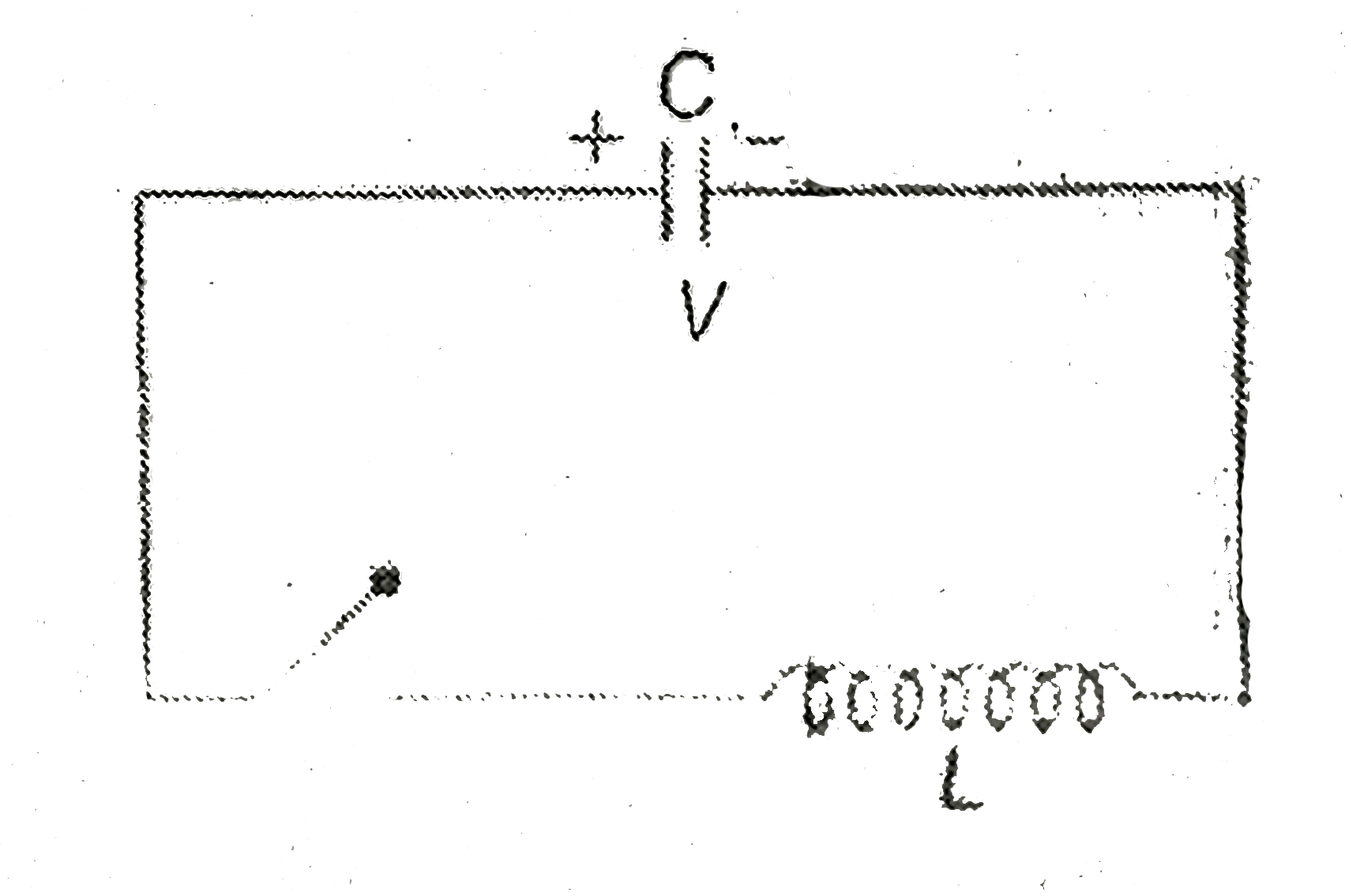A capacitor of capacitance C charged by battery at V volt and then disconnected. At t = 0, it is connected to an uncharged capacitor of capacitance 2C through a resistance R. The charge on the second capacitor as a function of time is given by q=αCV3(1−e−3tβRC) then fing the value of αβ.
The correct Answer is:1
To solve the problem, we need to analyze the given circuit and the charge transfer between the capacitors. Here’s a step-by-step solution:
Step 1: Understand the Initial Conditions
Initially, we have a capacitor of capacitance C charged to a voltage V. The charge on this capacitor is given by:
Q0=CV
This capacitor is then disconnected from the battery.
Step 2: Connect the Capacitors
At t=0, the charged capacitor C is connected to an uncharged capacitor 2C through a resistor R. The charge Q will flow from capacitor C to capacitor 2C.
Step 3: Charge Conservation
The initial charge on capacitor C is CV. When charge Q flows to capacitor 2C, the remaining charge on capacitor C becomes:
Qremaining=CV−Q
Step 4: Voltage Across the Capacitors
The voltage across capacitor C is:
VC=QremainingC=CV−QC=V−QC
The voltage across capacitor 2C is:
V2C=Q2C
Step 5: Apply Kirchhoff's Voltage Law
According to Kirchhoff's law, the sum of the potential differences around the loop must equal zero:
VC=V2C+IR
Substituting the expressions for VC and V2C:
V−QC=Q2C+IR
Where I=−dQdt.
Step 6: Rearranging the Equation
Rearranging gives:
V−QC−Q2C=−RdQdt
Combining terms:
V−3Q2C=−RdQdt
Step 7: Separate Variables
Rearranging for separation of variables:
dQ2CV−3Q2C=−dtR
Step 8: Integrate
Integrating both sides:
∫2C2CV−3QdQ=−∫dtR
This leads to:
ln(2CV−3Q)=−tR+k
Where k is the constant of integration.
Step 9: Solve for Q
Exponentiating both sides gives:
2CV−3Q=e−tR+k
At t=0, Q=0:
2CV=ek⟹k=ln(2CV)
Thus:
2CV−3Q=2CVe−tR
Rearranging gives:
Q=2CV3(1−e−3t2RC)
Step 10: Identify α and β
Comparing with the given function:
Q=αCV3(1−e−3tβRC)
We see that:
- α=2
- β=2
Step 11: Calculate αβ
Thus:
αβ=22=1
Final Answer
The value of αβ is 1.
---
Initially, we have a capacitor of capacitance C charged to a voltage V. The charge on this capacitor is given by:
Q0=CV
This capacitor is then disconnected from the battery.
At t=0, the charged capacitor C is connected to an uncharged capacitor 2C through a resistor R. The charge Q will flow from capacitor C to capacitor 2C.
The initial charge on capacitor C is CV. When charge Q flows to capacitor 2C, the remaining charge on capacitor C becomes:
Qremaining=CV−Q
The voltage across capacitor C is:
VC=QremainingC=CV−QC=V−QC
The voltage across capacitor 2C is:
V2C=Q2C
According to Kirchhoff's law, the sum of the potential differences around the loop must equal zero:
VC=V2C+IR
Substituting the expressions for VC and V2C:
V−QC=Q2C+IR
Where I=−dQdt.
Rearranging gives:
V−QC−Q2C=−RdQdt
Combining terms:
V−3Q2C=−RdQdt
Rearranging for separation of variables:
dQ2CV−3Q2C=−dtR
Integrating both sides:
∫2C2CV−3QdQ=−∫dtR
This leads to:
ln(2CV−3Q)=−tR+k
Where k is the constant of integration.
Exponentiating both sides gives:
2CV−3Q=e−tR+k
At t=0, Q=0:
2CV=ek⟹k=ln(2CV)
Thus:
2CV−3Q=2CVe−tR
Rearranging gives:
Q=2CV3(1−e−3t2RC)
Comparing with the given function:
Q=αCV3(1−e−3tβRC)
We see that:
- α=2
- β=2
Thus:
αβ=22=1
The value of αβ is 1.
Topper's Solved these Questions
- CAPACITANCEBOOK - RESONANCE ENGLISHCHAPTER - CAPACITANCEEXERCISE - Exercise - 3
26 Videos
- CAPACITANCEBOOK - RESONANCE ENGLISHCHAPTER - CAPACITANCEEXERCISE - High Level Problems
16 Videos
- CAPACITANCEBOOK - RESONANCE ENGLISHCHAPTER - CAPACITANCEEXERCISE - Exercise - 1
79 Videos
- ATOMIC PHYSICSBOOK - RESONANCE ENGLISHCHAPTER - ATOMIC PHYSICSEXERCISE - Advanved level problems
17 Videos
- COMMUNICATION SYSTEMSBOOK - RESONANCE ENGLISHCHAPTER - COMMUNICATION SYSTEMSEXERCISE - Exercise 3
13 Videos
Similar Questions
A capacitor of capacitance C is given a charge Q. At t=0,it is connected to an uncharged of equal capacitance through a resistance R. Find the charge on the second capacitor as a function of time.
View SolutionA capacitor of capacitance C is given a charge q0. At time t=0 it is connected to an uncharged capacitor of equal capacitance through a resistance R. Find the charge on the first capacitor and the second capacitor as a function of time t. Also plot the corresponding q-t graphs.
View Solution
Knowledge Check
A capacitor or capacitance C1 is charge to a potential V and then connected in parallel to an uncharged capacitor of capacitance C2. The fianl potential difference across each capacitor will be
AC1VC1+C2BC2VC1+C2C1+C2C1D1−C2C1
A capacitor of capacitance C0 is charged to potential V0. Now it is connected to another uncharged capacitor of capacitance C02. Calculate the heat loss in this process.
View SolutionA capacitor of capacitnace C is charged to a potential difference V and then disconnected from the battery. Now it is connected to an inductor of inductance L at t=0. Then

View SolutionA capacitor of capacitance C1 is charged to a potential difference V and then connected with an uncharged capacitor of capacitance C2 a resistance R. The switch is closed at t = 0. Choose the correct option(s):
View SolutionA capacitor of capacitance as C is given a charge Q. At t=0,it is connected to an ideal battery of emf (ε)through a resistance R. Find the charge on the capacitor at time t.
View SolutionA capacitor of capacitance as C is given a charge Q. At t=0,it is connected to an ideal battery of emf (ε)through a resistance R. Find the charge on the capacitor at time t.
View SolutionA capacitor of capacity 20microF is charged upto 500V and and disconnected from cell. Now this charged capacitor is connected to another capacitor of capacitance C If final common potential is 20V then find the capacitance C.
View SolutionA capacitor of capacitance value 1μF is charged to 30 V and the battery is then disconnected. If it is connected across a 2μF capacotor, then the energy lost by the system is
View Solution